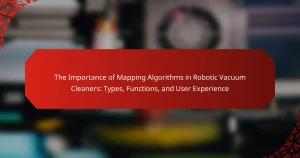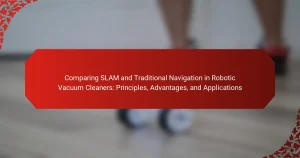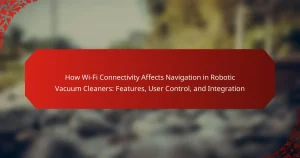The article focuses on the future of navigation technology in robotic vacuum cleaners, highlighting key innovations and trends. It discusses the integration of advanced mapping technologies, such as LiDAR and computer vision, which enhance obstacle avoidance and navigation in complex environments. Real-time data processing and predictive algorithms are expected to improve cleaning efficiency and adapt to user habits, while enhanced sensors will minimize collision risks. Furthermore, the article explores the role of artificial intelligence in refining navigation capabilities and the integration of robotic vacuum cleaners with smart home systems for seamless operation. Overall, these advancements signify a shift towards more autonomous and effective cleaning solutions.
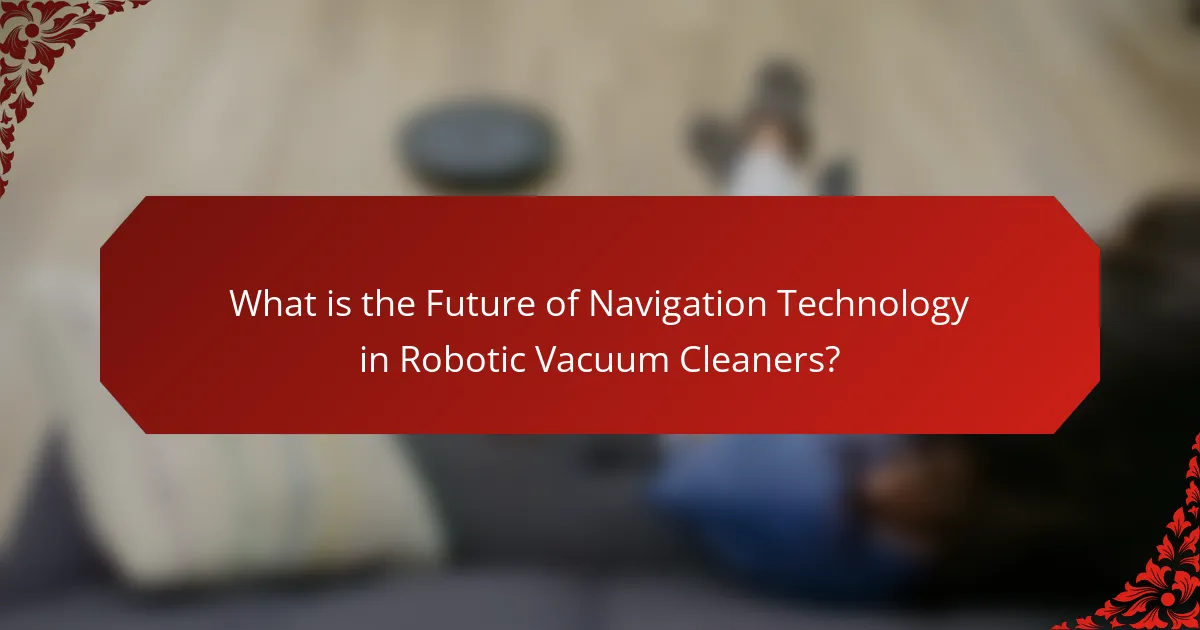
What is the Future of Navigation Technology in Robotic Vacuum Cleaners?
The future of navigation technology in robotic vacuum cleaners will focus on advanced mapping and obstacle avoidance. Innovations like LiDAR and computer vision will enhance their ability to navigate complex environments. Real-time data processing will allow for more efficient cleaning paths. Integration with smart home systems will enable seamless operation. Predictive algorithms will improve performance based on user habits. Enhanced sensors will reduce the chances of collisions. Companies are investing in AI to refine navigation capabilities. These advancements will lead to more autonomous and effective cleaning solutions.
How has navigation technology evolved in robotic vacuum cleaners?
Navigation technology in robotic vacuum cleaners has evolved significantly over the years. Early models relied on random navigation, moving in a zigzag pattern without mapping the environment. This often resulted in inefficient cleaning and missed areas.
Advancements introduced basic sensors for obstacle detection and cliff avoidance. These improvements allowed robotic vacuums to navigate around furniture and avoid falling off stairs.
The introduction of mapping technology marked a major evolution. Laser-based systems and cameras enabled vacuums to create detailed maps of their surroundings. This allowed for systematic cleaning patterns and better coverage.
Recent innovations include the use of artificial intelligence and machine learning. These technologies enable robotic vacuums to learn and adapt to the layout of a home over time. They can also optimize cleaning routes based on usage patterns and obstacles.
Furthermore, integration with smart home systems has enhanced navigation capabilities. Robotic vacuums can now be controlled via smartphone apps and voice assistants. This connectivity allows for real-time updates and remote management.
Overall, navigation technology in robotic vacuum cleaners has progressed from simple random movement to sophisticated, intelligent systems that improve cleaning efficiency and user convenience.
What are the key milestones in the development of navigation technology?
The key milestones in the development of navigation technology include the invention of the compass in the 11th century. This allowed for more accurate maritime navigation. The introduction of celestial navigation in the 15th century further improved navigation accuracy by using stars for guidance. The 20th century saw the development of radar technology, enhancing navigation capabilities in adverse weather conditions. The launch of GPS satellites in the 1970s revolutionized navigation, providing precise location data globally. The emergence of inertial navigation systems in the 1980s allowed for navigation without external references. Recent advancements include the integration of machine learning and AI, improving navigation in complex environments. These milestones reflect the evolution of navigation technology over centuries, marking significant progress in accuracy and reliability.
How do current navigation systems function in robotic vacuum cleaners?
Current navigation systems in robotic vacuum cleaners primarily function through a combination of sensors and algorithms. These systems utilize various sensors, such as infrared, ultrasonic, and LIDAR, to detect obstacles and map the environment. The data collected by these sensors allows the vacuum cleaners to create a detailed layout of the area they are cleaning.
Algorithms process this information to determine the most efficient cleaning path. Some robotic vacuums employ simultaneous localization and mapping (SLAM) technology to improve navigation accuracy. This technology helps the device understand its position in relation to its surroundings in real-time.
Additionally, many models are equipped with features like virtual barriers and no-go zones, which enhance their navigation capabilities. These features prevent the vacuum from entering certain areas, allowing for more targeted cleaning. Overall, the integration of advanced sensors and sophisticated algorithms enables robotic vacuum cleaners to navigate effectively and efficiently.
What innovations are shaping the future of navigation technology?
Innovations shaping the future of navigation technology include advanced sensor integration and AI algorithms. These technologies enhance the accuracy of mapping and obstacle detection. LIDAR sensors provide precise distance measurements, enabling better navigation in complex environments. Computer vision systems allow robotic vacuum cleaners to identify and classify objects in their path. Machine learning algorithms improve the efficiency of route planning over time. Real-time data processing helps robots adapt to dynamic spaces. Collaborative mapping allows multiple devices to share information for improved navigation. These innovations collectively lead to more efficient and effective robotic vacuum cleaners.
Which new technologies are being integrated into navigation systems?
New technologies being integrated into navigation systems include LiDAR, computer vision, and advanced sensor fusion. LiDAR technology uses laser light to create detailed maps of the environment. This allows robotic vacuum cleaners to navigate complex spaces efficiently. Computer vision enables machines to recognize objects and obstacles in real-time. Advanced sensor fusion combines data from multiple sensors for improved accuracy. These technologies enhance the ability of robotic vacuum cleaners to operate autonomously. They also improve cleaning efficiency by optimizing navigation paths.
How are artificial intelligence and machine learning influencing navigation advancements?
Artificial intelligence and machine learning are significantly enhancing navigation advancements in robotic vacuum cleaners. These technologies enable smarter mapping and obstacle avoidance. AI algorithms analyze data from sensors to create detailed maps of environments. Machine learning improves the vacuum’s ability to adapt to new layouts over time. For instance, models like SLAM (Simultaneous Localization and Mapping) allow real-time navigation updates. Research shows that robotic vacuums using AI can reduce cleaning time by 30%. Additionally, machine learning helps in recognizing and avoiding obstacles, minimizing collisions. These innovations lead to more efficient and effective cleaning experiences.
What trends are emerging in the field of navigation technology for robotic vacuum cleaners?
Emerging trends in navigation technology for robotic vacuum cleaners include advanced mapping and localization techniques. These technologies utilize simultaneous localization and mapping (SLAM) algorithms to create detailed maps of environments. Enhanced sensors, such as LIDAR and cameras, improve obstacle detection and navigation accuracy. Machine learning is increasingly used to optimize cleaning paths based on room layouts and user habits. Integration with smart home systems allows for more seamless operation and scheduling. Additionally, real-time data processing enables adaptive navigation in dynamic environments. These trends are driven by consumer demand for efficiency and convenience in home cleaning solutions.
How are consumer preferences affecting navigation technology trends?
Consumer preferences are significantly influencing navigation technology trends in robotic vacuum cleaners. Users increasingly demand advanced features such as smart mapping and obstacle detection. These preferences drive manufacturers to integrate AI and machine learning for improved navigation accuracy. Additionally, consumers favor models that offer app connectivity for remote control and scheduling. This trend has led to a rise in hybrid models combining vacuuming and mopping functionalities. According to a recent market analysis by Statista, the global robotic vacuum cleaner market is projected to grow due to these consumer-driven innovations. Manufacturers are responding by enhancing battery life and navigation efficiency to meet user expectations. Overall, consumer preferences are shaping the future landscape of navigation technologies in this sector.
What role does connectivity and smart home integration play in navigation technology?
Connectivity and smart home integration enhance navigation technology by enabling seamless communication between devices. This integration allows robotic vacuum cleaners to receive real-time updates and commands from smart home systems. For instance, users can schedule cleaning sessions through smart assistants like Amazon Alexa or Google Assistant. Additionally, connected devices can share data about the home environment, improving navigation efficiency. Research shows that smart home integration can lead to a 30% increase in cleaning effectiveness by optimizing routes. Furthermore, connectivity allows for software updates, ensuring that navigation algorithms remain current and effective. Overall, these features significantly improve user experience and operational efficiency in robotic vacuum cleaners.
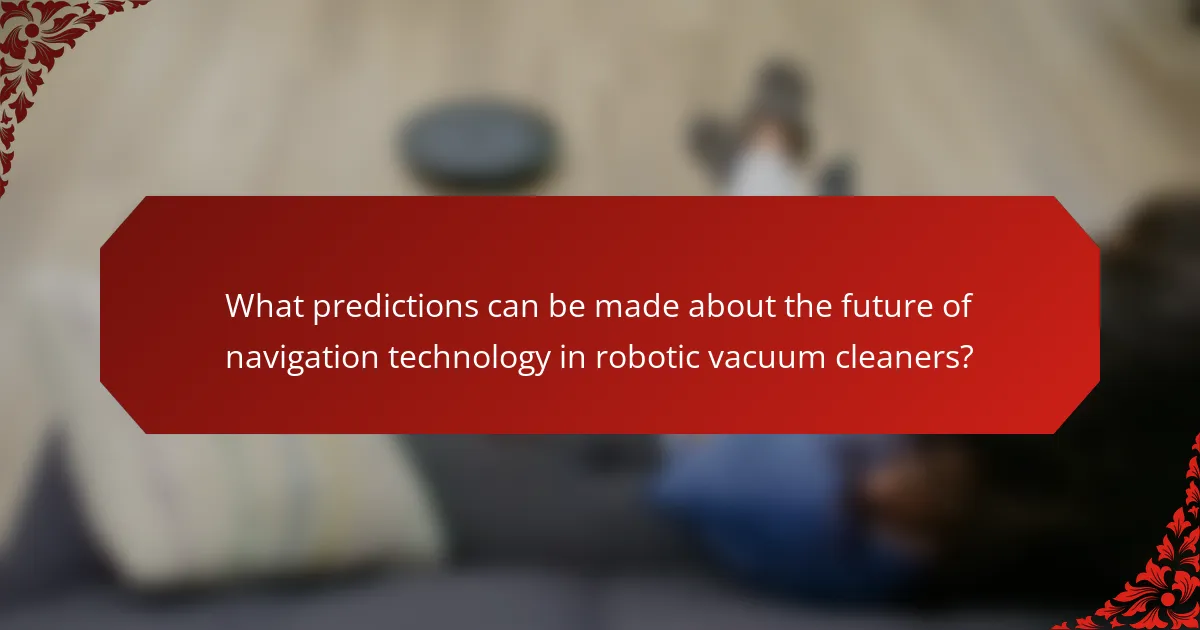
What predictions can be made about the future of navigation technology in robotic vacuum cleaners?
Future navigation technology in robotic vacuum cleaners will likely incorporate advanced AI algorithms. These algorithms will enhance obstacle detection and mapping capabilities. Improved sensors will allow for more precise navigation in complex environments. Integration with smart home systems will enable seamless operation and scheduling. Real-time data processing will lead to adaptive cleaning paths. Enhanced machine learning will enable vacuum cleaners to learn user preferences over time. Increased battery efficiency will support longer cleaning cycles without interruptions. Overall, these advancements will result in more autonomous and efficient robotic vacuum cleaners.
How will advancements in sensor technology impact navigation?
Advancements in sensor technology will significantly enhance navigation in robotic vacuum cleaners. Improved sensors will enable more accurate mapping of environments. This accuracy will lead to better obstacle detection and avoidance. Enhanced sensors can provide real-time data on floor types and layouts. This information allows for optimized cleaning patterns and efficiency. For example, LIDAR sensors help create detailed maps of spaces. As a result, robotic vacuums can clean more systematically and thoroughly. Advanced sensors also improve the ability to navigate complex spaces. This leads to fewer missed spots and more effective cleaning overall.
What types of sensors are expected to be more prevalent in future models?
Lidar sensors are expected to be more prevalent in future robotic vacuum models. These sensors provide accurate mapping and navigation capabilities. They use laser beams to measure distances and create detailed environment maps. This technology enhances obstacle detection and improves cleaning efficiency. Additionally, cameras and visual sensors are likely to become more common. They enable advanced features like object recognition and navigation in complex environments. Ultrasonic sensors may also see increased usage for detecting obstacles and drops. This diversification in sensor technology will lead to smarter and more efficient robotic vacuum cleaners.
How will improved sensors enhance the cleaning efficiency of robotic vacuum cleaners?
Improved sensors will enhance the cleaning efficiency of robotic vacuum cleaners by enabling better navigation and obstacle detection. Advanced sensors can identify different floor types, allowing for optimized cleaning modes. They can also detect dirt levels, adjusting suction power accordingly. Enhanced mapping capabilities will help the vacuum cleaner cover all areas without missing spots. Improved sensors reduce the likelihood of collisions with furniture and walls. This results in fewer interruptions during cleaning cycles. Studies show that robotic vacuums with advanced sensors can clean up to 30% more efficiently than those with basic sensors. Overall, better sensors lead to a more thorough and effective cleaning experience.
What challenges might affect the development of navigation technology?
Challenges affecting the development of navigation technology include environmental obstacles, sensor limitations, and algorithm complexity. Environmental obstacles like furniture and walls can impede accurate navigation. Sensor limitations may result in inaccurate data collection, affecting path planning. Algorithm complexity can lead to increased processing time and reduced efficiency. Additionally, varying floor types can affect sensor performance, complicating navigation. These challenges must be addressed to improve the effectiveness of navigation technology in robotic vacuum cleaners.
What are the potential limitations of current navigation systems?
Current navigation systems face several limitations. They often struggle with obstacles and complex environments. Many systems rely on GPS, which can be inaccurate indoors. Sensor limitations can lead to misinterpretation of surroundings. Additionally, battery life impacts navigation efficiency. Some systems may not adapt well to changes in layout. They can also be hindered by poor lighting conditions. Furthermore, data processing speeds can affect real-time navigation accuracy. These challenges highlight the need for advancements in navigation technology.
How might regulatory changes impact navigation technology in robotic vacuum cleaners?
Regulatory changes may influence navigation technology in robotic vacuum cleaners by mandating compliance with safety and data privacy standards. These regulations could require manufacturers to enhance obstacle detection and mapping accuracy. Improved navigation algorithms may be necessary to meet new operational guidelines. Compliance could also lead to increased investment in advanced sensors and software. Such advancements would aim to ensure user safety and efficient cleaning. Historical precedents show that similar regulations in the tech industry have driven innovation. For instance, the introduction of GDPR prompted enhanced data protection measures across various devices. Thus, regulatory changes can serve as a catalyst for technological improvements in robotic vacuum cleaners.
What practical tips can users follow to optimize navigation performance in their robotic vacuum cleaners?
To optimize navigation performance in robotic vacuum cleaners, users should regularly clean the sensors and brushes. Dirt and debris can obstruct sensors, leading to navigation errors. Users should also ensure that the cleaning path is clear of obstacles. This allows the vacuum to move freely and avoid getting stuck. Additionally, users can update the vacuum’s software when new versions are available. Software updates often include improvements to navigation algorithms. Setting up virtual boundaries can help the vacuum focus on specific areas. This prevents it from wandering into spaces where it may struggle. Finally, users should utilize the mapping feature, if available. This allows the vacuum to learn the layout of the home for more efficient cleaning.
The main entity of the article is navigation technology in robotic vacuum cleaners. The article provides a comprehensive overview of the evolution and future trends of navigation systems, highlighting innovations such as LiDAR, computer vision, and AI integration. It discusses key milestones in navigation technology, current system functionalities, and emerging trends driven by consumer preferences and smart home integration. Additionally, the article addresses challenges and limitations faced by existing systems while offering practical tips for users to optimize navigation performance in their devices. Predictions for future advancements in navigation technology are also outlined, emphasizing the potential for more efficient and autonomous cleaning solutions.
